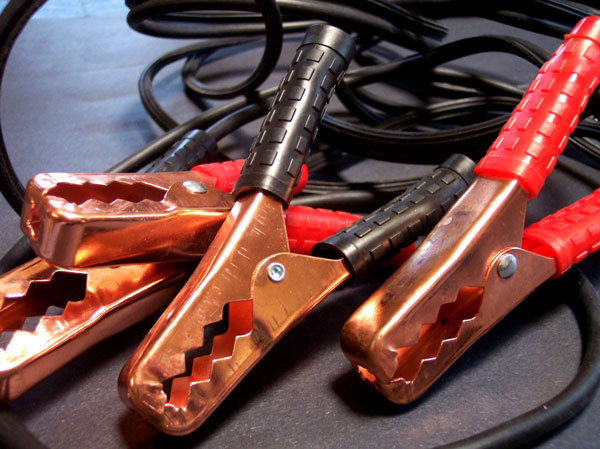 WAIT, BEFORE YOU SCROLL DOWN! While I know a lot about cars, I don't know a lot about YOUR CAR! A repair manual is essential and I have a way for you to get one FREE.
WAIT, BEFORE YOU SCROLL DOWN! While I know a lot about cars, I don't know a lot about YOUR CAR! A repair manual is essential and I have a way for you to get one FREE. Click Here To Read More(Link opens in a new window)
On The Road
Car Won't Start
Check the battery terminals and make sure they are tight. Try to turn on the lights for a second then turn them off. This is sometimes enough to reestablish a good connection. Read below for more diagnostic tips.
Not sure which connections go where when jump starting a car?
Good battery car: Red (+) cable to (+) terminal of battery & Black (-) cable to (-) terminal of battery. Dead battery car: Red (+) cable to (+) terminal of battery & Black (-) cable to metal ground on engine. Read below for the full procedure.
The Automotive Electrical System

How does my cars electrical system work?
Learn how the automotive electrical system works in your car. From the Battery, Starter, Alternator and Cables, we will look at how to keep your electrical system operating properly. When it comes to getting your electical system serviced, follow the tips below to make sure your mechanic fixes it right the first time.
2020 COVID Update
If you are like many working from home and getting groceries delivered, your car is not being used often. Make sure you start and run your car at least once a week for 15 minutes or so to completely warm up. Drive it if you can to prevent flat spots on your tires and get everything lubricated (transmission, axle etc). If your battery is getting towards the end of it's life or you have some unknown current draws (security system or other add-ons) you may need to run it more often.
If you can not start it every week a trickle charger would be a good investment, especially if your car is stored in the garage close to an electrical outlet.
Common Problems:
- The battery is usually the first part of the system to wear out. Most batteries last between 3 and 7 years depending on brand and design. Batteries can be fine on minute, and dead the next. More on this later.
- Blown fuse: Is one part of the electrical system not working like the interior lights or dash lights? Your first thing to check is the fuses. Look for the fuse panel under the dash, in the glove box, or even in the engine compartment in some cars. Most fuse boxes will be labeled by circuit. Modern cars use a blade type fuse which is rectangular in shape and transparent. Look for the wire which runs through the fuse and see if it is burned through. Any discoloring of the fuse is a good sign the fuse has blown. If you have doubts, replace with a new fuse and test the system which is not working.
- Alternator: Does your car start ok, but your headlights dim when idling. It could be a bad alternator. When the alternator can not produce enough electricity to keep the electrical systems running and the battery will have to be used to take up the slack. This will eventually wear down the battery and not allow your car to start.
Troubleshooting:
I don't think there is a tougher system to troubleshoot on your car than the charging/starting system. This is due to the fact that there are many things that can go wrong and it's tough to test some components without special equipment. Let's go over some possible situations and their possible causes.
- First check all battery cables for corrosion as this will keep power from flowing freely to the starting system. If they are dirty, clean with a wire brush and reattach. ( Click Here For an Example of a Battery Brush )Apply a light coat of grease to the top of the terminals to prevent further corrosion.
- Battery could not have enough power stored in it to spin the engine. This can be caused by a bad cell in the battery or from a bad alternator not charging the battery when the engine is running. If you can get the car to a mechanic, have him or her test the battery and charging system with a special tester. This tester places a load on the battery and can tell the condition. They can also check to see if the alternator is working to it's full potential.
- Starter or solenoid could be bad. If you can not jump start the car and all of the battery cables are ok then suspect the starter.
- Check battery cables as above.
- Have the battery tested. There could be a bad cell causing a short. You can try jump starting but often the car will not stay running.
- Grinding noises point to the starter not properly meshing with the flywheel. This can be caused by a bad solenoid or a bad spot on the flywheel.
- I have also seen starters loosen up so they no longer contact the flywheel at the proper distance. While not common, it is something to keep in mind.
- Look to the alternator for problems. Take the car to your mechanic to have the alternator checked for proper operation.
- Check for loose wires going to the alternator. Also check for corrosion as this will inhibit the alternator from charging properly.
- Check the tension on the alternator belt. If it is too loose, the belt may slip and not drive the alternator properly.
- Replace your battery every 4 years as a safety measure. It will save allot of headaches down the road.
- If your battery is not a sealed unit, check fluid levels in each cell. Only fill with distilled water and be careful around the acid which is in the battery.
- Check your alternator belt frequently for cracks and tension. Replace per your cars manufacturers recommendations.
- Clean your battery connections at least once a year. Parts stores sell a handy terminal cleaner which is basically a round wire brush which works wonders. Once you reattach the terminals, coat with a layer of heavy grease or special purpose grease sold at parts stores. This layer will block the air from reacting with the connectors and creating corrosion.
Car won't start, all I hear is a click but the engine does not turn.
Car won't start, I hear nothing.
Car won't start, all I hear is a horrible grinding noise.
Car starts but my headlights are dim at low engine speeds.
As you can see there are plenty of things to go wrong with the charging system and it is always best to take the car to your mechanic and have it tested before you go replacing parts blindly.
Preventing problems with your electrical system:
How to jump start your car:
 Jump starting your car does not have to be a hard task. First lay out the cables on the ground between the two cars. Make sure that the cable is not tangled and none of the end clamps are touching each other. The car with the good battery should be running.
Jump starting your car does not have to be a hard task. First lay out the cables on the ground between the two cars. Make sure that the cable is not tangled and none of the end clamps are touching each other. The car with the good battery should be running.
Step 1: Take the positive (red) clamp closest to the car with the good battery and hook it to the positive terminal of that car. The positive terminal will have a + sign on it and usually a red wire running to it.
Step 2: Repeat this step on the car with the bad battery, hooking up the positive clamp to the positive terminal on the battery. Make sure the clamps are contacting well and can not fall off.
Step 3: Take the negative cable (black) closest to the car with the good battery and hook it to the negative terminal of the battery. The negative terminal will have a - sign and usually a black wire running to it.
Step 4: This is the last step and the most important. Take the negative clamp closest to the car with the bad battery and attach it to a bare metal part of the engine. DO NOT hook it to the batteries negative terminal as there maybe hydrogen gas present from the battery and a spark from the connection could cause an explosion.
That's it...... turn the key on the dead car and the car should start. If it does not, try revving the engine on the good car to boost the charge coming from the alternator. If this does not work, try wiggling the cables to assure you have a good connection. A GOOD set of jumper cables are a necessity. I have had cheaper sets not jump start a dead car. I actually had to double up two cheap sets to get enough current to start my car. The cheaper sets will have thinner cables which can not carry enough amperage to start some stalled cars. I would suggest buying a cable which has 4,6 or 8 gauge wire.